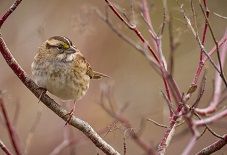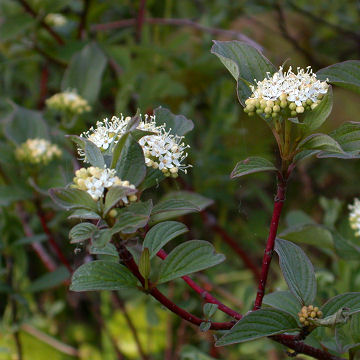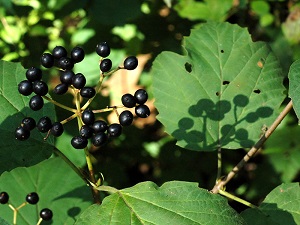by guest author Bridget Butler, “the Bird Diva.”

White-throated sparrow in a red osier dogwood
As a light blanket of snow covers the ground and I watch chickadees and finches at my feeders, I think about how I can continue to add more food sources to my backyard. And not just by adding feeders, but by adding native shrubs, plants and trees that will provide not only for my winter friends, but for the variety of birds that will return in the spring.
In the past few years, I’ve been slowly removing invasive shrubs like buckthorn and honeysuckle and replacing them with shrubs native to Vermont that have a high wildlife value, especially for birds. My two favorite families of shrubs are the viburnums and the dogwoods. With a variety of species adapted to different soils and exposure to the sun, it’s relatively easy to find one that will work in any backyard.
When choosing shrubs to plant for songbirds, you’ll want to start to think like a bird. Birds need food, cover and nesting sites when it comes to how they use the landscape. Providing a variety of native trees, shrubs and plants will maximize the number of opportunities you provide the birds to eat, nest and hide. A great resource to learn more about attracting birds through your landscaping choices is Trees, Shrubs and Vines for Attracting Birds, by Richard M. DeGraaf.
Viburnums and dogwoods tend to be a “triple threat” so-to-speak because they cover all the bases when it comes to fulfilling songbird needs. Flowers change to berries that provide great fall foraging for migrants, and many have a dense form perfect for taking cover in and a branching structure strong enough to support nesting.
Here are the first two I added to my yard and some of their awesome attributes:
Red Osier Dogwood, aka Cornus sericea

Red-osier dogwood in bloom
Look for the bright red twigs of this shrub along the side of roadways during the winter. It forms beautiful, upright thickets especially along ponds and streams or wet meadows. I’ve planted it as a border shrub along our property line where there’s a wet swale. In the summer it has lovely white flowers which turn into berries throughout the summer and its foliage will add to the autumn colors in your yard. It’s a preferred nesting site for the American Goldfinch and a preferred food source for 14 species of birds including Swainson’s Thrush, Brown Thrasher, Ruffed Grouse and Cedar Waxwing.
Other delightful dogwoods for birds include Alternate-leaf Dogwood (C. alternifolia), Silky Dogwood (C. amomum) and Gray Dogwood (C. racemosa).

Fruiting maple-leaved viburnum.
Maple Leaf Viburnum, aka Viburnum acerifolium
This one will catch your eye as their crimson berries slowly fade to purple in the fall and sometimes hold their berries through the winter. A great boost for American Robins sticking around during a mild winter. I’ve planted this shrub a little closer to the house where the soil is drier. In the wild, Maple Leaf Viburnum is an understory shrub in our forests and tolerates partial to full sunlight. Viburnums are treasured by 26 species of birds, mostly for their berries but many of our game birds and our thrushes love the dense branches and foliage for cover. You can expect viburnums to attract hungry fall migrants like the Rose-breasted Grosbeak, Wood Thrush and White-throated Sparrow.
Other fabulous viburnums include American Cranberrybush (V. trilobum), Nannyberry (V. lentago) and Wild Raisin (V. nudum).






